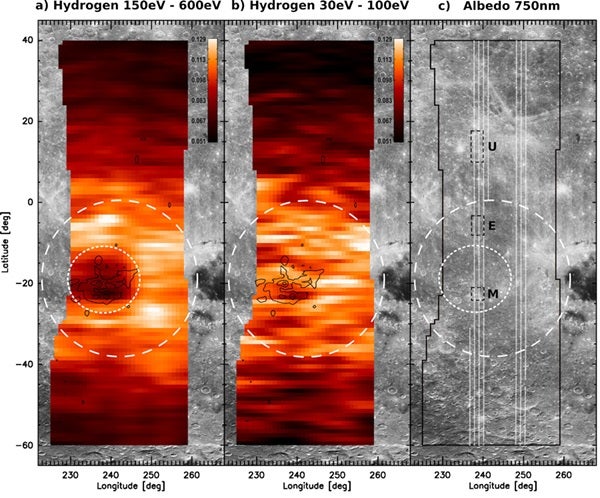Scientists have discovered a new type of solar wind interaction with airless bodies in our solar system. Magnetized regions called magnetic anomalies, mostly on the farside of the Moon, were found to strongly deflect the solar wind, shielding the Moon’s surface. This will help scientists understand solar wind behavior near the lunar surface and how water may be generated in its upper layer.
Atmosphere-less bodies interact with the solar wind quite differently than with Earth. Their surfaces are exposed without any shielding by a dense atmosphere or magnetosphere. This causes them to be heavily weathered by meteoroids or the solar wind, forming a rough and chaotic surface called regolith. Previously, scientists thought the regolith completely absorbed the solar wind. However, recent explorations of Earth’s Moon by the Chang’E-1, Kaguya, and Chandrayaan-1 spacecrafts have revealed that this interaction is not that simple.
A significant flux of high-energy particles was found to originate from the lunar surface, most probably due to the solar wind directly reflecting off the Moon’s regolith.
“These results may change dramatically the way we understand the solar wind-regolith interaction so far,” said Yoshifumi Futaana of the Swedish Institute of Space Physics.
“Since the solar wind is one potential source of water on the Moon, we need to make better models of the lunar hydrogen circulation in order to understand how water molecules form in its upper layers,” said Futaana. “Also, it will be possible to remotely investigate the solar wind-surface interaction on other airless bodies, such as Mercury or the martian moon Phobos, by imaging the energetic hydrogen atoms that are reflected back to space when the solar wind hits their surface.”
The current investigation was carried out with the Sub-keV Atom Reflecting Analyzer instrument flown aboard the Indian Chandrayaan-1 spacecraft. Scientists have mapped for the first time the energetic hydrogen atoms coming from the Moon, and found that up to one-fifth of the solar wind protons reaching the lunar surface are reflected back to space.
This may be a general feature of the atmosphere-less bodies, such as Mercury, meteorites, and several moons of the giant planets.
“In fact, during the close encounter of the European Mars Express spacecraft with Phobos in 2008, we detected signatures of reflected solar wind protons also from the surface of the martian moon Phobos,” said Futaana.
However, when Chandrayaan-1 flew over a magnetic anomaly on the lunar surface, the scientists detected significantly less reflected hydrogen atoms, meaning that the solar wind had not reached the lunar surface. In fact, the solar wind was strongly deflected by an aggregation of magnetic anomalies in the southern hemisphere of the lunar farside. “We detected a strong flux of deflected solar wind protons,” said Futaana. “This clearly indicates that magnetic anomalies can shield the lunar surface from the incoming solar wind in the same way as the magnetospheres of several planets in our solar system.”
“It all depends on how strong the solar wind blows,” said Wieser, also of the Swedish Institute of Space Physics. “When the solar wind pressure is low, this mini-magnetosphere expands, causing stronger shielding.”










